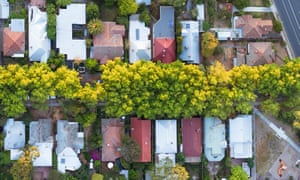A crash in Australia’s “unprecedented” housing market could lead to a broader economic downturn, according to a report from the OECD.
In its first major review of the Australian economy since 2014, the OECD warned the housing market was showing “hints of a slowdown”, in what it identified as an “extreme vulnerability” for the economy.
“A large drop-off in house prices could cut household consumption and increase mortgage defaults … The market may not ease gently but develop into a rout on prices and demand with significant macroeconomic implications,” they said.
“A continued rise of the market, fuelled by both investor and owner-occupier demand, may end in a significant downward correction that spreads to the rest of the economy.”
Australia’s house prices have increased by 250% in real terms since the mid 1990s, with the median house price in Sydney hitting almost $1m at the end of January.
The OECD
attributed this boom to domestic buyers rather than foreign investment,
and recommended government policy should pressure banks to limit
mortgage lending for investment properties, and avoid risky loans –
echoing 2014 measures already put in place by the Australian Prudential
Regulation Authority.
Household debt also rose to record levels, with the debt to disposable income ratio rising to 186.9% at the end of September last year. However, the report noted household debt was “concentrated in high income households”, and was balanced by rising asset values and low interest rates.
A global plunge in iron and coal prices was also identified as another major vulnerability, and the OECD noted the economy still faced “challenges” in the gender pay gap and in greenhouse gas emissions.
It recommended an emissions trading scheme be adopted if carbon reduction targets “beyond those brought about by the Direct Action Plan” were needed.
“The price of carbon emissions in Australia is low, with large shares of emissions in industry, electricity, agriculture and fisheries are not priced at all. This weakens the incentives to cut carbon in a cost-effective manner,” the report said.
In its first major review of the Australian economy since 2014, the OECD warned the housing market was showing “hints of a slowdown”, in what it identified as an “extreme vulnerability” for the economy.
“A large drop-off in house prices could cut household consumption and increase mortgage defaults … The market may not ease gently but develop into a rout on prices and demand with significant macroeconomic implications,” they said.
“A continued rise of the market, fuelled by both investor and owner-occupier demand, may end in a significant downward correction that spreads to the rest of the economy.”
Australia’s house prices have increased by 250% in real terms since the mid 1990s, with the median house price in Sydney hitting almost $1m at the end of January.
Household debt also rose to record levels, with the debt to disposable income ratio rising to 186.9% at the end of September last year. However, the report noted household debt was “concentrated in high income households”, and was balanced by rising asset values and low interest rates.
A global plunge in iron and coal prices was also identified as another major vulnerability, and the OECD noted the economy still faced “challenges” in the gender pay gap and in greenhouse gas emissions.
It recommended an emissions trading scheme be adopted if carbon reduction targets “beyond those brought about by the Direct Action Plan” were needed.
“The price of carbon emissions in Australia is low, with large shares of emissions in industry, electricity, agriculture and fisheries are not priced at all. This weakens the incentives to cut carbon in a cost-effective manner,” the report said.

No comments:
Post a Comment